We now live in a modern, consumerist and largely urbanised world where environmental protection is a key concern related to the future of humanity. Economists, environmentalists, development professionals and academics are concerned about the problems that cropped up when taking efforts to promote development ignoring the environmental dimensions of development. In the 1980s, the term 'sustainable development' started to be used to describe development which takes account of environmental consequences. So when we talk about 'sustainable development', we are talking about using our intelligence and scientific knowledge to satisfy our needs while maintaining the physical environment. The Commonwealth publication 'Sustainable Development and Environmental Issues' explores the need for the world to bring about sustainable development, that is a balance between development and environmental protection. The 'Rio Declaration on Environment and Development, 1992' states: "In order to achieve sustainable development, environmental protection should constitute an integral part of the development process and cannot be in isolation from it". It also highlights that youths have an important role to play in bringing about environmental protection and sustainable development for ensuring a better future for all.
The module is divided into four units. The first unit aims to enhance our awareness of key concepts related to the natural environment and the major environmental problems facing the world today. Unfortunately, most of our developmental activities have simply exploited the earth's raw materials and released large quantities of waste energy and toxic materials back into the system. We are faced with many threats to our environment: the greenhouse effect, global warming, acid rain, ozone depletion, soil erosion and so on. This unit also aims to provide us with materials that we can use to start an education programme for young people to raise their awareness of the environment. A basic programme in environmental awareness provides a sound foundation for young people to participate in projects that address environmental problems. Finally, the unit looks at the more complex concepts that are important for understanding sustainable development: inter-connectivity, sacredness, and renewable and non-renewable resources.
Unit-2 discusses the social environment and its relationship to the natural or physical environment. It examines different aspects of social environment that can affect the physical environment: value systems, legislation, and global economics. This unit also examines some of the issues that were raised at a world youth environmental meeting, Juventud (Youth)'92, held in San Jose, Costa Rica. Young people from all over the world discussed their concerns about the environment and raised the following issues at that meeting: poverty and the environment, external debt, population growth, and natural resource degradation. 'How can young people bring about a change?' Considering this question, the unit explores some of the complex and inter-related issues. The third unit of the module examines the major events that have caused the world to focus on the need for environmental protection, in particular the 1992 Earth Summit. The Earth Summit conference, held in Rio de Janeiro, was an important milestone in history. It helped awaken the world to the need for a development process that does not endanger future generations. This unit also discusses the role and opportunities for young people to participate in sustainable development activities.
The last unit of the module further examines the meaning of sustainable development in its application to planning and evaluating projects. It starts by examining the elements of a sustainable development project, and then looks at how these are reflected in the general objectives laid out in the World Resources Institute's model. The World Resources Institute sets out a model containing the general objectives of a sustainable development plan for the earth. These objectives have been grouped into four categories-economic, human (social), environmental and technological. This unit also reflects on how the World Bank model evaluates sustainable development projects. In general, the World Bank evaluates the impact of programmes and applications for loans using two methods: the sustainability matrix, and sustainability as opportunity. Finally, this unit concludes with some examples (i.e. case studies) of the practical approaches to sustainable development adopted by youth organisations in the Commonwealth countries.
S. M. Rayhanul Islam is an independent researcher.


